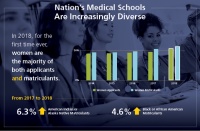Association of American Medical Colleges
aamc.org
Data show increasing diversity among applicants and enrollees
(Black PR Wire) The nation’s medical schools made notable gains in diversifying their entering classes in 2018, according to new data released today by the AAMC (Association of American Medical Colleges), which show increases in the number of women and those from some racial and ethnic groups applying to and enrolling in medical school this fall.
For the first time since 2004, more women than men applied to U.S. medical schools, comprising 50.9% of applicants. Women were also the majority of matriculants (new enrollees) to medical school for the second year in a row (51.6% versus 50.7% in 2017).
The 2018 data also show that the nation’s medical schools continue to attract and enroll more racially and ethnically diverse classes. The number of black or African American applicants increased by 4.0%, to 5,164 this year, while matriculants rose by 4.6% to 1,856 students. The gains for black or African American men are especially noteworthy, after years of minimal growth or declines: the number of applicants from this group grew 4.4%, to 1,851, and the number of matriculants rose 7.3%, to 734.
American Indian or Alaska Native applicants rose by 10.0% to 559 and matriculants increased by 6.3%, to 218 this year. Despite this gain, a new report released by the AAMC and the Association of American Indian Physicians shows that American Indians and Alaska Natives have experienced slow and uneven gains in representation across the medical education continuum over the past 30 years.
Overall, the total number of applicants to medical schools rose by 2.1%, to 52,777, after a 2.6% decline last year. The number of matriculants grew by 1.3%, to 21,622. Women applicants increased by 5.0% and women matriculants increased by 3.2% this year. Men applicants and matriculants both declined by less than 1%.
“This year’s significant gains in the number of women and black men entering medicine is excellent news,” said Darrell G. Kirch, MD, AAMC president and CEO. “Medical schools have been working hard to increase the diversity of tomorrow’s doctors. While there is still much more work to do, we are very encouraged by this year’s progress.”
As in past years, medical school enrollees in 2018 had strong academic credentials: The average undergraduate GPA was 3.72 and the average MCAT® score was 511. This year’s entering class also demonstrates a strong commitment to service, cumulatively performing more than 12.5 million community service hours.
The growth in the number of medical school applicants and matriculants occurs at the same time there is a significant projected shortage of up to 121,300 physicians by 2030. To address this shortage, the nation’s medical schools have expanded class sizes, and 26 new schools have opened in the past decade. The number of medical school applicants has increased by 57% (19,154 applicants), and the number of matriculants has grown by more than 31% (5,134 matriculants) since 2002. Today, more than 2,000 new students are enrolled at one of the 26 medical schools that have opened, representing nearly 10% of all matriculants.
“Medical schools have expanded their enrollment to educate the additional physicians our nation needs to care for a growing and aging population, as well as address health crises, such as the opioid epidemic,” Kirch said. “But we will not sufficiently increase overall supply of physicians in the United States without creating more residency slots. It is more important than ever for Congress to lift the 1997 cap on federal support for residency positions to ensure that all patients have access to the care they need.”
The Association of American Medical Colleges is a not-for-profit association dedicated to transforming health care through innovative medical education, cutting-edge patient care, and groundbreaking medical research. Its members are all 152 accredited U.S. and 17 accredited Canadian medical schools; nearly 400 major teaching hospitals and health systems, including 51 Department of Veterans Affairs medical centers; and more than 80 academic societies. Through these institutions and organizations, the AAMC serves the leaders of America’s medical schools and teaching hospitals and their more than 173,000 full-time faculty members, 89,000 medical students, 129,000 resident physicians, and more than 60,000 graduate students and postdoctoral researchers in the biomedical sciences.
# # #

